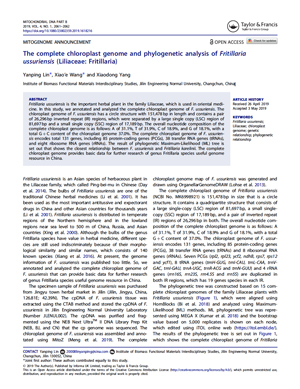NEWS 2019
The complete chloroplastgenome and phylogenetic analysis of Fritillaria ussuriensis (Liliaceae: Fritillaria)
Yanping LIN, Xiao’e WANG, Xiaodong YANG
Mitochondrial DNA Part B, 4:1, 2061-2062 (2019)
https://doi.org/10.1080/23802359.2019.1618216
Institute of Biomass Functional Materials Interdisciplinary Studies, Jilin Engineering Normal University, Changchun, China
Abstract
Fritillaria ussuriensis is the important herbal plant in the family Liliaceae, which is used in oriental medicine. In this study, we annotated and analyzed the complete chloroplast genome of F. ussuriensis. The chloroplast genome of F. ussuriensis has a circle structure with 151,478 bp in length and contains a pair of 26,296 bp inverted repeat (IR) regions, which were separated by a large single copy (LSC) region of 81,697 bp and a small single copy (SSC) region of 17,189 bp. The overall nucleotide composition of the complete chloroplast genome is as follows: A of 31.1%, T of 31.9%, C of 18.9%, and G of 18.1%, with a total GflC content of the chloroplast genome 37.0%. The complete chloroplast genome of F. ussuriensis encodes total 131 genes, including 85 protein-coding genes (PCGs), 38 transfer RNA genes (tRNAs), and eight ribosome RNA genes (rRNAs). The result of phylogenetic Maximum-Likelihood (ML) tree is set out that shows the closest relationship between F. ussuriensis and Fritillaria karelinii. The complete chloroplast genome provides basic data for further research of genus Fritillaria species useful genome resource in China.




